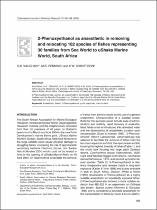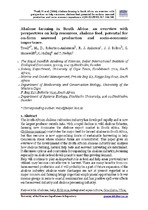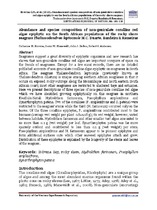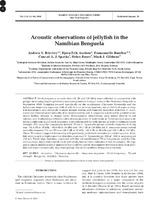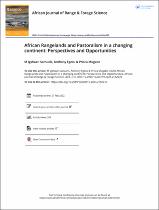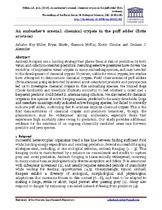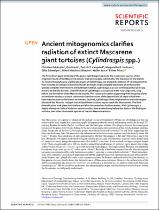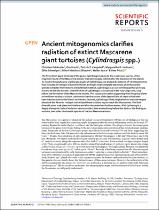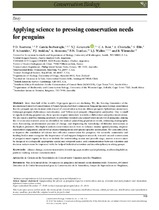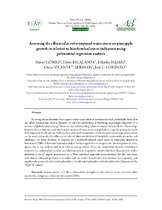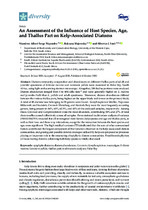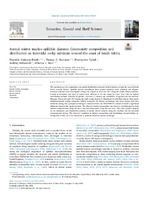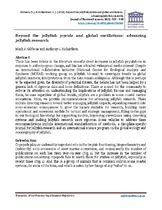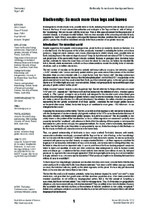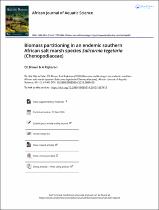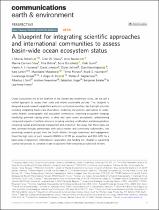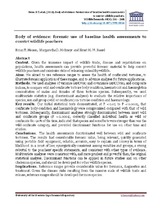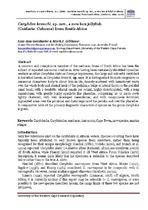Browsing Research Articles (Bioversity and Conservation Biology) by Title
Now showing items 1-20 of 252
-
2-phenoxyethanol as anaesthetic in removing and relocating 102 species of fishes representing 30 families from sea world to uShaka Marine World, South Africa
(AOSIS, 2008)The South African Association for Marine Biological Research, incorporating Sea World, Oceanographic Research Institute and the Dolphinarium relocated from their old premises of 46 years on Durban’s beach front in March ... -
Abalone farming in South Africa: an overview with perspectives on kelp resources, abalone feed, potential for on-farm seaweed production and socio-economic importance
(Elsevier, 2006)The South African abalone cultivation industry has developed rapidly and is now the largest producer outside Asia. With a rapid decline in wild abalone fisheries, farming now dominates the abalone export market in South ... -
Abundance and species composition of non-geniculate coralline red algae epiphytic on the South African populations of the rocky shore seagrass Thalassodendron leptocaule M.C. Duarte, Bandeira & Romeiras
(Elsevier, 2013)Seagrasses support a great diversity of epiphytic organisms and new research has shown that non-geniculate coralline red algae are important occupiers of space on the fronds of seagrasses. Except for a few scant records, ... -
Acoustic observations of jellyfish in the Namibian Benguela
(Inter-Research, 2001)Multi-frequency acoustic data (18, 38 and 120 kHz) were collected in conjunction with pelagic trawl sampling for gelatinous macrozooplankton during a cruise to the Namibian Benguela in September 1999. Sampling focused ... -
African rangelands and pastoralism in a changing continent: Perspectives and opportunities
(Taylor and Francis Group, 2023)Eighty-five years ago, Africa was described as a land of promise because it provided an immense opportunity for maximum return in the minimum time (Olaniyan 2000). It was treated this way because ... -
African rangelands and pastoralism in a changing continent: perspectives and opportunities
(Taylor and Francis Ltd, 2023)Eighty-five years ago, Africa was described as a land of promise because it provided an immense opportunity for maximum return in the minimum time (Olaniyan 2000). It was treated this way because it was considered more for ... -
An ambusher’s arsenal: chemical crypsis in the puff adder (Bitis arietans)
(The Royal Society, 2015)Ambush foragers use a hunting strategy that places them at risk of predation by both visual and olfaction-oriented predators. Resulting selective pressures have driven the evolution of impressive visual crypsis in many ... -
Ancient mitogenomics clarifies radiation of extinct mascarene giant tortoises (cylindraspis spp.)
(scientific reports, 2019)The five extinct giant tortoises of the genus Cylindraspis belong to the most iconic species of the enigmatic fauna of the Mascarene Islands that went largely extinct after the discovery of the islands. To resolve the ... -
Ancient mitogenomics clarifies radiation of extinct Mascarene giant tortoises (Cylindraspis spp.)
(Nature research, 2019)The five extinct giant tortoises of the genus Cylindraspis belong to the most iconic species of the enigmatic fauna of the Mascarene Islands that went largely extinct after the discovery of the islands. To resolve the ... -
Applying science to pressing conservation needs for penguins
(Wiley-Blackwell, 2020)More than half of the world's 18 penguin species are declining. We, the Steering Committee of the International Union for Conservation of Nature Species Survival Commission Penguin Specialist Group, determined that the ... -
Assessing the effects of in vitro imposed water stress on pineapple growth in relation to biochemical stress indicators using polynomial regression analysis
(AcademicPres, 2020)Knowing the mechanisms that operate under water stress in commercial crops, particularly those that can affect productivity, such as phenolic or cell wall metabolism, is becoming increasingly important in a scenario of ... -
An assessment of the influence of host species, age, and thallus part on kelp-associated diatoms
(MDPI, 2020)Diatom community composition and abundances on different thallus parts of adult and juvenile specimens of Ecklonia maxima and Laminaria pallida were examined in False Bay, South Africa, using light and scanning electron ... -
Austral winter marine epilithic diatoms: Community composition and distribution on intertidal rocky substrate around the coast of South Africa
(Elsevier, 2020)The knowledge on the composition and spatial distribution of marine benthic diatoms around the coast of South Africa remains limited. Epilithic diatom assemblages from natural intertidal rocky substrate and physico-chemical ... -
Beyond the jellyfish joyride and global oscillations: advancing jellyfish research
(Oxford University Press, 2013)There has been debate in the literature recently about increases in jellyfish populations in response to anthropogenic change, and this has attracted widespread media interest. Despite an international collaborative ... -
Biocontrol Potential of Bacillus subtilis and Bacillus tequilensis against Four Fusarium Species
(MDPI, 2023)The use of biological control agents as opposed to synthetic agrochemicals to control plant pathogens has gained momentum, considering their numerous advantages. The aim of this study is to investigate the biocontrol ... -
Biodiversity: so much more than legs and leaves
(AOSIS OpenJournals, 2013)Microorganisms inhabit virtually every possible niche on Earth, including those at the outer envelope of survival. However, the focus of most conservation authorities and ecologists is the ‘legs and leaves’ side of biology ... -
Biomass partitioning in an endemic southern African salt marsh species Salicornia tegetaria (Chenopodiaceae)
(Taylor and Francis Group, 2020)The below ground biomass of salt marsh species accounts for more than half of the total plant biomass in salt marsh systems, yet no biomass data exist for salt marsh species in South Africa. ... -
A blueprint for integrating scientific approaches and international communities to assess basin-wide ocean ecosystem status
(Nature Research, 2023)Ocean ecosystems are at the forefront of the climate and biodiversity crises, yet we lack a unified approach to assess their state and inform sustainable policies. This blueprint is designed around research capabilities ... -
Body of evidence: forensic use of baseline health assessments to convict wildlife poachers
(CSIRO Publishing, 2013)CONTEXT. Given the immense impact of wildlife trade, disease and repatriations on populations, health assessments can" "provide powerful forensic material to help convict wildlife poachers and minimise risks of releasing ... -
Carybdea branchi, sp. nov., a new box jellyfish (Cnidaria: Cubozoa) from South Africa.
(Magnolia Press, 2009)A common and conspicuous member of the medusan fauna of South Africa has been the subject of repeated taxonomic confusion. After having been mistakenly identified by earlier workers as either Carybdea alata or Tamoya ...

